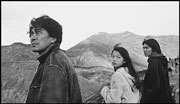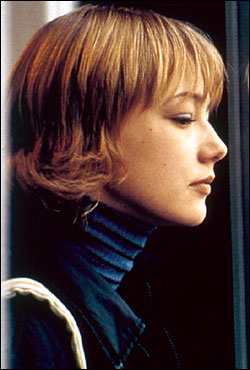EUREKA
written and directed by Shinji Aoyama with Koji Yakusho, Aoi Miyazaki, Masaru Miyazaki, and Yohichiroh Saitoh opens May 4 at Uptown
IN HIS TOWERING, transcendent Eureka, writer-director Shinji Aoyama takes a well-worked form, the road movie, and elevates it so that by the end we have watched a man and two children move from pain and withdrawal to something close to redemption. Don’t let Eureka‘s three-hour, 40-minute running time put you off; I’ve seen 90-minute movies that feel longer. Winner of two Cannes prizes last May, Eureka has no fat and no indulgent sequences. Within Aoyama’s sweeping vistas, time seems to fly.
The story opens on a deceptively ordinary sunny morning in semi-rural southwest Japan. From a grassy hill above the bus stop, a mother waves goodbye to her son Naoki and younger daughter Kozue (real-life brother and sister Masaru and Aoi Miyazaki) as they set off for middle school.
Eureka is shot in CinemaScope and black-and-white using color stock, which gives it a muted sepia tone. The technique heightens the scene’s almost fairy-tale look: this lovely mother in a long flowing dress, her hair nearly waist length under her straw hat. It’s Aoyama’s deliberate counterpoint to what follows, a way of dividing the film irrevocably into an idealized past and a nightmarish present.
Among the quiet citizens filing onto this nearly empty city bus is a deranged young man with a gun. By the end of the next scene the only three left alive are the now-mute, traumatized children and Makoto, the driver (the tall, charismatic Koji Yakusho of Shall We Dance? and The Eel). Our first clue to Aoyama’s style is how scrupulously he avoids exploiting this sequence; another is a moment much later in the film when a sandal, floating downstream, tells us all we need to know about the fate of its wearer. (The eloquent cinematography is by Masaki Tamra.)
THE BUS TRAGEDY is compounded for all three survivors. Given to night sweats and survivor’s guilt, Makoto abruptly leaves his family to wander aimlessly. The kids’ situation is made even more stark when, in a single long high-angle shot, we watch their mother calmly walk away from her children and their abusive father (who dies soon afterward while driving drunk).
After two years, Makoto returns to find that his wife has left and his stern father has disinherited him. While working as a day laborer, Makoto’s path crosses that of the orphaned kids. Their father’s life insurance has provided money enough to live on, but they’ve stopped going to school and live in their huge two-story house like drugged, feral animals, their kitchen a Styrofoam mountain of old takeout boxes.
Makoto moves in with them, bringing kindness and order (even as all three continue to suffer panic attacks). There’s the sense in this knotty-pine Westernized house that the wagon train has circled against all comers. The last to enter the compound is the kids’ cousin Akihito (Yohichiroh Saitoh), a jangly, funny college kid on school break. He warns them that his family—their eyes on the kids’ money—is poised to descend.
Branded a suspicious vagrant, Makoto is briefly jailed in connection with the deaths of two young village women. Once freed, that’s reason enough for him to outfit a bus and take all three kids across Kyushu’s uncluttered island landscape on an extraordinary journey, both outward and inward.
During his time in jail, Makoto hears and returns quiet taps from the next cell, which provide comfort and some measure of reassurance. Later, in their bus, Makoto’s taps quiet the troubled Kozue and with the whole of Eureka, Aoyama sends that reassurance along to us: There is humanity in the world. Tap, tap, tap.








